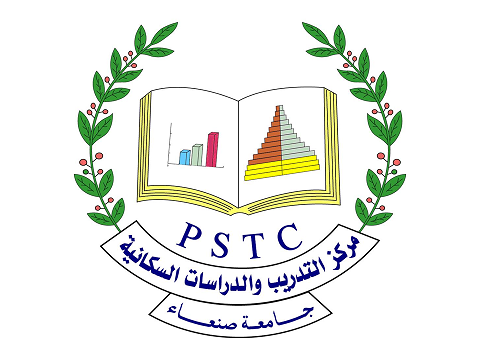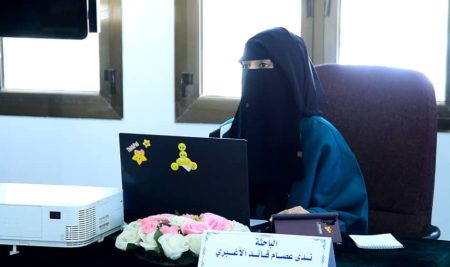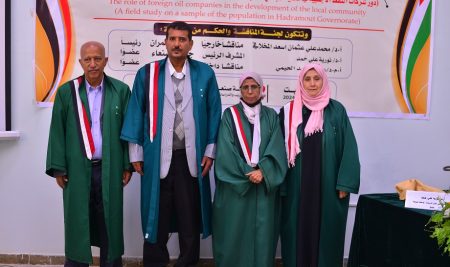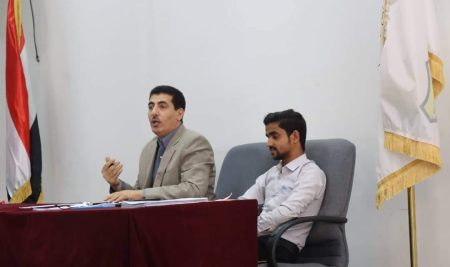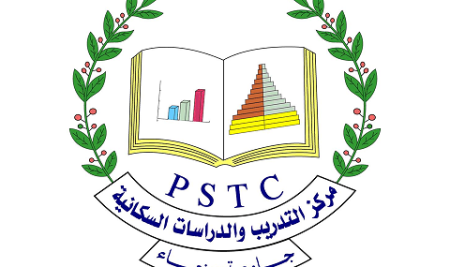

Population Studies and Training Center (PSTC)
PO Box: 11183
Tel: 464631-1-967+
Fax: 464632-1-967+
Sana’a University Website:
E-mail: pstc. su@y.net.ye
In the Name of Allah, Most Merciful, Most Gracious
A number of graduates from the Centre are about to finish their studies. Specialized in demographic studies, these graduates’ future mission and assignment are address population problems, representing some of the most vital concerns blocking all sorts of development of underdevelopment nations, in general, and our homeland in particular. Yemen has one of the highest population growth rate in the world, accounting for (3.02%), which goes beyond its potentials and scanty natural resources.
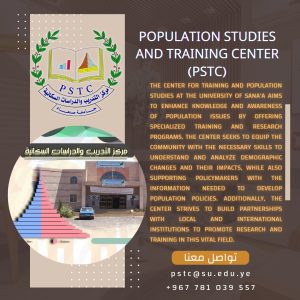
Vision
The Center for Training and Population Studies at the University of Sana’a aspires to be a leader in research and training related to population issues by enhancing scientific understanding and analyzing demographic data. The center seeks to achieve a positive impact on the community and decision-makers by providing accurate and reliable information, which contributes to the development of effective policies that meet the needs of the population and promote sustainable development. Additionally, the center aims to establish a network of local and international partnerships to enhance its research and training programs.
Message
The Center for Training and Population Studies at the University of Sana’a aims to enhance knowledge and awareness of population issues by providing specialized training and research programs. The center seeks to equip the community with the necessary skills to understand and analyze demographic changes and their impacts, as well as to support decision-makers with the information needed to develop population policies. Additionally, the center strives to build partnerships with local and international institutions to promote research and training in this vital field.
Foreword:
From the time of the march towards achieving a holistic and sustainable development ensued by the Yemeni Government, State-officials, academicians, and community leaders started to develop stronger perception of the strong and significant link between population growth and the five-year socio-economic plans adopted and devised by Yemen. The first general census of population and housing (and other facilities) to this very day was carried out to learn more about the effects of Yemen’s annual population growth on the various aspects of life and living. Since then and to this very day, Yemen has been witnessing rapidly intense changes and accomplishments, especially with the accomplishment of the Yemen’s Reunification on 22 May 1990. The new established Republic of Yemen was capable of making large leaps and feats in various areas, including economic, social, political, security, environment fields. Albeit of being able to eliminate poverty, Yemen still has a lot of commitments to fulfill and challenges to overcome; some include bettering the standard of living of the population as a whole, delivering outreach services to urban and rural areas. This, nonetheless, demands concerted efforts from all in order to realize the realize the dimensions of population growth and their link and impact on achieving a comprehensive and sustainable development adopted by the State .
In line with the above, Sana’a University, represented by the Population Studies and Training Center committed itself to undertake the implementation of many various activities appertaining to population concerns and development matters. It also conducted many studies and facilitated and held workshops focusing mainly on population and development concerns. More importantly is that many graduates completed the High Diploma program centering on matters appertaining to demographic and development issues. The program was joined by many candidates concerned with population studies from ministries, institutions, authorities of the public sector and those of the private sector as well as Civil Society Organizations’ affiliates. It had a significant impact in raising the awareness of the candidates towards the importance of linking population growth with the holistic development process undertaking by the Government of Yemen. As a result, the significance of assessing the program academically, administratively and financially came to being. This however was not the case in the past as the program used to be offered in accordance with the Scientific Council’s Decision. Yet, new program assessment emphasized that changes taking place in various living aspects ought to be taken into consideration when setting up new ones, a matter which the Center underlines in order to be the beating heart of relevant activities and functions conducted at the University. The Center further underscored that it is highly essential to tie the State’s trends and policies conductive for achieving comprehensive and sustainable development with population issues and concerns.
For sure, this Manual, which clearly explicates the tasks and reflects the expectations of the Center’s affiliates, would strengthen the relation among public universities, ministries, state-owned authorities, agencies and entities on one hand and the privately-owned universities, institutions, agencies and CSO’s, on the other.
We do hope that this new Manual would present a clear picture of the Center’s objectives and mission for the sake of strengthen the Center’s role at the University, state and community level. It is expected that the use of the Manual would enable the Center to prepare and qualify skilled cadre having the potentials and aptitude to understand and realize changes locally taking place in the field of development. The Center’s graduates would be able to accurately perceive or forecast Yemen’s future based on its annual population growth rate and predict its impacts on all of walks of life. It is, then, possible to effectively and efficiently address population issues at their current status and overcome the impact of population growth on the process of development and the life of future generations.
Last but not least, I would like to extend my warm thanks and sincere gratitude to my fellow members of the Scientific Council, the Research and Population Studies Department for their unfailing support, cooperation and determination to make the Department achieve and fulfill its mission. This is in order to galvanize and strengthen the role of the Center and promote its outputs, wishing everybody great success and progress and prosperity for our homeland, Yemen.
The Population Studies and Training Center Objectives:
The notion of establishing the Center incorporates a set of objectives to be hopefully achieved. Most include the followings:
To promote the efforts exerted by the State for expanding the sphere of scientific knowledge on the impact of population growth on various walks of life;
To develop and improve the particulars and contents of the courses appertaining to demographic matters that are offered by colleges at various universities;
To keep materials and knowledge on population matters updated and accessible through the provision of up-to-date information and necessary resources for faculty staff members of Yemeni universities and for postgraduate candidates at various colleges;
To have the Center make use of findings of surveys conducted by state-owned institutionsand regional and internationalorganizations when conducting its populationresearchand studies;
To hold and deliver general and specialized lectures and facilitate workshops and seminars on population issues and matters at the universities, institutes, etc.;
To prepare a library equipped with references, books, periodicals and publications pertaining to population and have halls for computers in order for researchers benefit from such services;
To hold training and qualifying courses for affiliates of Yemeni universities, ministries, state-owned authorities and agencies as well as CSO’s and NGO’s working in the areas related to population, reproductive health, family planning, environmental planning and manpower planning as well.
To conduct field researches and studieson various demographic issues with special focus on the economic and social aspects and the environment as well as reproductive health, family planning and education, etc. This could be via the Center contracting with other agencies interested in doing such researches and studies;
To assess projects and programs implemented by ministries and authorities, agencies, CSO’s and NGO’s and offer the required counseling on areas appertaining to population and human resources development and their requirements as necessary by statistical fields, etc.;
To meet the needs of various agencies via initiating training programs and courses for those working for such agencies; and assess the inputs and outputs of training courses and programs in coordination with these agencies based on their circumstances and job requirements;
To have the Center offer an academic and scientific training and qualification program for a period of not less than one academic year via devising and preparing a High Diploma Program on Demographic Studies endorsed by competent academic bodies ( such as (Council of Graduate Studies and the University Council).
To have the Center offer an MA program for candidates who graduated with a grade of Good or above from their BA programs; the same shall hold true with regards to the Diploma Program;
To have the Center work on mainstreaming and integrating population issues into university education and train respective teaching staffs of different Yemeni universities on accomplishing this mission;
Units of the Center Name
Latest News
Center Name
su_53_pstc
December 22, 2025
Master’s Degree Awarded to Ms. Hanan Nasser Saleh Mohammed Hajib in Population Studies
su_53_pstc
September 21, 2025
PhD Degree Awarded to Ms. Amal Al-Matari in Population Studies
su_53_pstc
January 29, 2025
Master’s Degree for StudentNada Essam Qa’ed Abdullhaq Al-Aghbari at the Population Studies and Training Center
su_53_pstc
October 8, 2024
Announcement of the convening of the Center’s Councils on Saturday, September 28, 2024
Latest Publications
Center Name
admin
April 11, 2021
scientific
admin
April 11, 2021
Research name
su_53_pstc
October 8, 2024
Announcement of the convening of the Center’s Councils on Saturday, September 28, 2024
admin
April 11, 2021
news title 3
admin
March 10, 2021
Published research
admin
April 11, 2021
